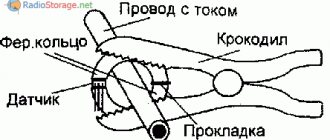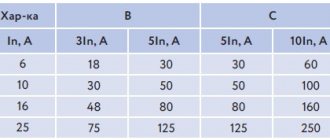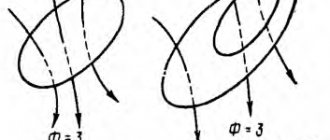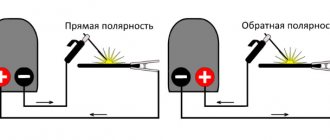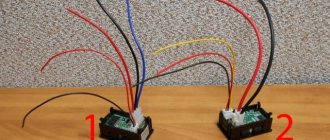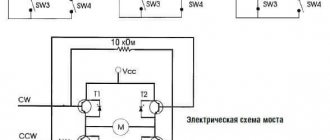Purpose of the device and its advantage
Current clamps or “ Dietze clamps ” are a measuring device whose purpose is to measure current in a non-contact manner, without breaking the electrical circuit. The main advantage over other multimeters and ammeters is the ease of measurement and safety of use, since the measurement can be carried out on an insulated conductor. Using this device, you can easily determine the exact indicators of electric current, as well as calculate the power consumption of any electrical equipment under load.
Operating principle and functionality
The operating principle of the device is based on the law of electromagnetic induction, and its design is largely similar to the operating principle of an ordinary transformer. The alternating current of the measured conductor inside the transformer coil (Clamps) creates an alternating magnetic flux that induces an emf in the secondary winding of the device, which is measured by an ammeter or sensor.
Circuit for measuring current strength with a device with a transformer sensor
More modern devices use a semiconductor Hall . The main difference from a device with a transformer is that the measured conductor is covered not by a closed coil, but by a magnetic circuit, in the gap of which a Hall sensor is placed.
Circuit for measuring current strength with a device with a Hall sensor
Modern devices, depending on the type, are capable of measuring alternating or direct and alternating current (through the use of a Hall sensor); most of them have advanced multimeter functionality and are able to display numerical information on the display. Depending on the brand and manufacturer, the meters have many additional functions and design solutions.
Purpose and types of current clamps
A clamp meter is perhaps the only tool that allows you to measure current in a circuit without breaking it. They differ in design, functionality, maximum measured voltage and type of measured current (DC or AC). So what could our ticks be and how do they work?
Let's start, perhaps, with the well-known one-handed pliers - essentially it is a multimeter (most often) with an additional current sensor. Using such clamps is quite simple - to do this, just switch the switch to ammeter mode, separate the clamps and bring them together, enclosing the conductor inside the ring. The current strength in this conductor will be displayed on the digital indicator.
To measure current in hard-to-reach places, some models have a button for fixing the result.
Such one-handed pliers are designed for relatively low (up to 1000 V) voltage and, due to their compactness and ease of use, are most suitable for use in domestic conditions.
Important! You can measure current only on a single conductor - if you cover both wires with clamps, you will get zero as a result. This happens due to the fact that a current flows in the conductors, equal in value, but different in direction. A result other than zero indicates the presence of a leak equal to the result obtained.
In addition to one-handed ones, two-handed ones are also produced, designed to work with voltages from 2000 to 10,000 V.
It is no longer possible to work with such pliers with one hand. Such an inconvenient design was invented for a reason. The fact is that, for safety reasons, current measuring devices intended for measurements above 1 kV must have an insulator length of at least 38 cm, and handles of at least 13 cm. Fortunately, such voltages are practically never encountered in everyday life, so work with two-handed Few people will need to use ticks.
As already mentioned, in addition to the maximum measured voltage, clamp meters also differ in the type of current measured. What are the differences between them and how do you know what type of current a particular device is designed for? This is actually not difficult - according to the markings on the body (now we mean pliers of high or at least medium quality, and not collected in the basement on your knees). Thus, on the housing of clamps intended for measuring alternating current, the marking will be AC, while for direct current - DC (more often - ACDC). The differences are in the operating principle. Current clamps for measuring alternating current operate on the principle of a single-turn transformer.
In general, the design of AC current clamps is simple. They consist of an adjustable magnetic circuit with a secondary winding wound on it, connected to an ammeter. The role of the primary winding is the conductor being measured, the current flowing through it creates an alternating magnetic field, transmitted through the magnetic circuit of the secondary winding and exciting electromagnetic induction in it. The resulting electric current is precisely measured by an ammeter. This diagram explains the working principle of AC current clamps, but how do DC current clamps work? After all, as you know, a transformer can only operate in alternating current circuits. Now we will get an answer to this question.
To measure direct current, different principles are used. It is well known that a conductor through which electric current flows creates a magnetic field around itself, and the higher the current strength, the more powerful this field is. So, by measuring this field, you can get an idea of the strength and even direction of the current. The presence and intensity of the magnetic field is determined by a special sensor (Hall sensor). Clamps equipped with a Hall sensor, unlike transformer clamps, are capable of measuring both direct and alternating current, and are slightly more expensive. So if you have to choose which ones are better to buy, then these are the ones that are recommended. In addition to its direct functions (measuring current without breaking the circuit), many modern clamps are a full-fledged tester (multimeter) that allows you to measure voltage, resistance, as well as ring sections of the circuit and check the performance of some radio elements.
But we should also not forget about analog (arrow) clamps, which, despite all the advantages and conveniences of their digital counterparts, still continue to be used along with them. This happens due to their lower cost and ability to work without a power source.
Now, knowing what current clamps can be, you can go directly to the review. Today's rating will feature 10 pliers from different manufacturers, different price categories, but certainly having high user ratings. The pliers will be positioned in ascending order of their quality.
Video - What are current clamps used for and why are they better than a multimeter?
Types of devices
There are two types of devices, the main difference being the measuring sensors:
- With electromagnetic sensor. Can only measure alternating current. The transformer clamp of such a tool is an openable magnetic circuit with a secondary coil that closes on the measuring sensor.
- With semiconductor Hall sensor. This type of device is capable of measuring direct or alternating current.
How can you easily determine the type of Dietz mite sensor? To do this, you need to open the clamp-shaped ring and look at its ends; if there are metal pads , it means the device has an electromagnetic sensor and has an openable magnetic circuit; it can only measure alternating current . If there are no metal plates at the ends or the plate is only at one end , then this is a meter with a Hall sensor, such a meter does not have a closed magnetic circuit, it can measure direct or alternating current , as a rule, such devices are a little more expensive.
Current clamps with electromagnetic sensor, closed magnetic circuit
Current clamps with Hall sensor, without closing magnetic circuit
Types of execution
Dietz meters are divided into analog and digital:
- Analog meters. As a rule, they can only measure alternating current; readings are taken from the built-in ammeter. Such instruments were widespread before the advent of digital meters.
- Digital (most popular). An integrated circuit is installed inside such devices; as a rule, they have advanced functionality or additional functions of a multimeter (tester).
Specialized high-voltage electrical clamps
A separate type should include special-purpose meters, measuring clamps Ts 90 (a more modern version Ts 4502 ), designed for measuring current in powerful electrical installations up to 10,000 volts . This instrument can only measure AC current from 15 to 600A . The principle of operation of the meter is similar to conventional transformer type meters; the design of such clamps is slightly modified for safe operation of the operator. The design includes an insulating part with insulating handles, and safety rules have been developed for making measurements using this method.
“Nowadays, with the development of technology, this method of measurement is practically not used due to the high risk of electric shock.”
Safety regulations
These are the basic rules for using electrical protective equipment and are suitable for all types:
- If special protective equipment is required, its suitability must first be checked. Firstly, attention is paid to the appearance of the device and its insulation. It must be free of dirt and damage to the outer casing, including paint.
- The suitability of each protective isolating device is also regularly checked using dedicated electrical test equipment. Therefore, before using a protective product, it is necessary to check its expiration date - the date of the next test on the stamp of the identified sample.
Device safety check
- If the electrical protection device is dirty, the housing is damaged, or the periodic test period has expired, it should not be used as this may result in electric shock.
- The electrical protective equipment to be used performs insulating functions only when dry. When it is necessary to work outdoors, it is necessary to avoid the use of protective equipment that has been exposed to moisture (rain, rain, frost, snow).
- If it is necessary to work in a damp environment, an electrical protective device specially designed for this purpose must be used.
You might be interested in this: Shredder attachment for grinder
Application of an insulated rod
- Protective insulating pliers must be kept clean. This is also true for gloves, shoes and other protective equipment: if caustic liquids and lubricants stick to the rubber surface, they will soon become unusable.
- Insulating pliers are used to replace the fuse. In addition to insulated marking lines, insulated gloves and safety glasses or face shields should be used as an additional protective measure when replacing fuses above 1000 V.
- The load must be disconnected before replacing the fuse. The exception is network fuses, which do not have switching devices, and the fuses can be removed without disconnection.
Insulating pliers are a necessary tool when performing live work. They must be kept clean, protected from moisture and quality checked regularly. The safety of work and the life of the worker depend on this.
Measurement procedure
Before starting measurements, it is necessary to determine the measurement location, prepare the device for operation, and move the rotary switch to the desired position. If the current strength is unknown , then it is necessary to set the maximum value of the range, then during the measurement, gradually reduce the indicator for a more accurate result. Devices with a Hall sensor , due to its sensitivity to magnetic fields, must be zeroed before measurement by pressing the appropriate "SEL" or similar "REL" button.
Before you start using the meter, read the user manual:
- Instructions for use of current clamp meters Mastech m266.
- Manual. Mastech M266, M266C, M266F passport.
“Be sure to follow safety precautions when working with electric current and electrical equipment. Carefully study the rules for using the device described in the instructions.”
Measurement procedure:
- Prepare the device and select the measurement location.
- Move the rotary switch to the desired position, then move the conductor to be measured into the device bracket.
It is important to place the wire at the intersection point of special centering indicators ; if they are not there, then place them, if possible, closer to the center, only in this case is it possible to obtain high measurement accuracy. If, when measuring direct current, the measurement result is displayed on the display with a minus sign, pay attention to the direction of the current on the side surface of the clamps; as a rule, an arrow-shaped current direction indicator is located in this part.
- Take readings from the display and, if necessary, save the data in the meter’s memory. It is best to measure the current strength several times to obtain a more accurate result.
The main rule when measuring is that the current must be measured in one of the conductors. If insulated conductors are additionally combined into one wire, for example, a TV wire or a kettle wire, then the measurement result may be incorrect or zero.
- For a more accurate result or to measure low current, if the conductor being measured allows it, make several turns around the clamp. Divide the resulting measurement result by the number of turns, as a result you will receive a revised measurement value.
Rating of the best current clamps - TOP 10
Current clamps are classified as highly specialized tools. Their range of tasks is clearly limited: measuring the strength and voltage of currents, resistance, capacitance, temperature, frequencies. At the same time, finding a model that combines all possible options at the same time is problematic.
The rating of the best current clamps presents the TOP of the most successful models with a competent combination of functions and ranges. The testers presented below are suitable for most types of work, both at home and in construction or when installing electrical networks.
FLUKE 302+
A professional and inexpensive device from an American brand, it is equipped with a shockproof housing, a bright display backlight for working in low light conditions, and an auto-shutoff function to save battery life. Among the advantages, users note the wide opening of the “pincers” - up to 3 cm, high accuracy of readings and a memory function for the last 5 values. Pincers are often included in various collections due to their high and stable measurement accuracy.
Advantages:
- high measurement accuracy;
- small dimensions and weight;
- large backlit display;
- high degree of protection against voltage surges;
- low cost in its class.
Flaws:
- sensitivity to low temperatures;
- There is no storage case included.
Mastech MS2008B
Inexpensive, but at the same time functional current clamps Mastech MS2008B have all the necessary options. Automatic and manual measurement ranges, dial-in mode, auto-off, ambient temperature measurement, DATA HOLD function, which allows you to save the latest values in memory. Additionally, the device is equipped with a convenient flashlight to illuminate the work area.
Advantages:
- affordable price;
- great functionality;
- built-in flashlight;
- light weight;
- durable body.
Flaws:
- inconvenient switching between modes;
- With frequent use, the buttons begin to stick.
CEM DT-3341
Owned by a Chinese company, the CEM brand is known in many countries around the world; the products of this company are certified according to various quality standards. The DT-3341 model, listed in the state registry, is designed to measure AC current, air temperature, DC/AC voltage, capacitance and resistance. Current clamps are equipped with high-quality screen backlighting, a convenient functional switch and a “dialing” function. The clamp size of the pliers is 3 cm, auto shut-off is triggered after 15 seconds. According to reviews, this is a good device for measuring direct and alternating voltage with a slight error.
Advantages:
- durable rubberized body;
- low cost;
- high measurement accuracy;
- presence of a cover included;
- 2 years official warranty;
- function switch.
Flaws:
- no memory function;
- Some batches of tools are supplied with inappropriate instructions.
UNI-T 13-0009 UT-210E
As users note, the UT-210E pocket compact device is an indispensable assistant in the household, as well as when repairing cars. The pliers are also suitable for professional use, including repairing air conditioners. The main advantages of the device are automatic selection of ranges, the ability to measure direct current min. 2A max. 100A, leakage to ground. The accuracy of these current clamps is comparable to professional models. The memory function, high-definition screen and small dimensions simplify the user's work, and the buttons are quite tight to avoid accidental pressing. Not included in the state register.
Advantages:
- ultra-small dimensions and weight;
- auto power off and memory function for last values;
- accuracy;
- sound sensor.
Flaws:
- small opening of pliers 170 mm;
- poor quality of the probes included in the kit.
CEM DT-360
One of the most budget-friendly measuring instruments, the DT-360, despite its modest functionality compared to more expensive clamps, belongs to the “pro” class. This is a good clamp meter at an affordable price, with which you can measure AC/DC voltage up to 600V, AC 400A, resistance. Useful functions include DATA HOLD, screen backlight, and battery charge indicator (crown). Entered into the state register.
Advantages:
- best price in its class;
- double impact-resistant housing;
- excellent combination of price and features;
- clear display of values on the screen;
- coverage up to 3 cm;
- clear algorithm of operation.
Flaws:
- early backlight shutdown 10 sec;
- There is no way to measure direct current.
BISON Professional PRO-824 (59824)
Current clamps from ZUBR are equipped with a wide grip up to 3 cm, a rubberized, shockproof body, and a MAX HOLD function, which allows the device to remember not only general, but also maximum values. The large backlit display makes it possible to see measurement results even in poor lighting conditions. The wide functionality, combined with the accuracy of the readings, significantly expands the scope of application: these are the best current clamps that are suitable for both home and work. It is not listed in the state register.
Advantages:
- there is a “continuity” mode, diode test;
- Ease of Management;
- indication of device overload;
- suitable for both domestic and professional use;
- measurement of maximum alternating current up to 1000 A.
Flaws:
- frequent warranty cases;
- no DC current measurement.
IEK Expert 266F
Simplicity of execution has significantly reduced the cost of the Expert 266F current clamps, but the manufacturer has retained all the functions necessary for domestic use. The device is equipped with a wide clamp up to 5 cm, an LCD monitor with a digital scale, and it is possible to take readings in a non-contact manner.
Advantages:
- convenient button for opening the pliers;
- Includes a carrying case;
- safety and reliability;
- ease of operation.
Flaws:
- very sensitive to low temperatures;
- Measures alternating current only.
STAYER 59820
The current measuring device of the German brand STAYER is characterized by users as an unpretentious, durable instrument. Its body is designed in such a way that the operator can take measurements with one hand. It is possible to diagnose electrical devices and connections without interrupting the voltage supply. This is a high-quality current measuring device with a long service life, designed for active use. For convenience, the manufacturer has added a convenient bag - a cover.
Advantages:
- clamp size 30 mm;
- digital data display;
- acceptable measurement accuracy;
- clear interface;
- supports temperature measurement;
- possibility of measuring AC/DC current.
Flaws:
- small display;
- difficult mode switching.
EKF MS2016S
MS2016S current clamps belong to the household class, however, due to their high-quality performance and high accuracy, the clamps have received many good reviews. The device automatically scans current and voltage, as well as resistance. The DATA HOLD option can store received data in memory and display it on a wide, digital display at the right time.
Advantages:
- the best combination of “price and quality”;
- clarity of instructions;
- memory for storing data.
Flaws:
- limited functionality.
RESANTA DT 266C
According to user reviews, RESANTA current clamps confidently cope with their task, and in terms of accuracy of readings they are not inferior to more expensive analogues. In addition to the standard set of options, the mites are capable of measuring air temperature. They are also equipped with a “dialing” sound signal, overload protection, and a rotary mode switch.
Advantages:
- good functionality;
- accuracy of measurements taken;
- additional overload protection;
- convenient design.
Flaws:
- weak beep;
- poor operation of the switch wheel;
- frequent warranty cases.
Functions and design features
Electrical clamps differ in electrical characteristics, measurement range, measurement accuracy and additional functionality. The main functions of the devices include:
- Ammeter
- Voltmeter
- Wattmeter
- Phase meter
- Ampere-voltmeter
Most devices have additional functions of a multimeter tester, which you should pay attention to when choosing a device:
- measurement of resistance, frequency, insulation
- diode check
- sound verification
- temperature detection
- inrush current measurement function
More advanced versions of the devices are equipped with additional auxiliary elements that help make more accurate measurements or measure in hard-to-reach places, these include:
- double Hall sensor ( more accurate meters )
- meters with external clamps
- Current clamp with removable display
- Flexible current sensor
- Increased clamping pliers
- Probe wires, “Crocodiles”
Device with removable pliers
Cost of digital clamp meters depending on characteristics
Depending on the price, all devices can be divided into an economy segment in the price range from 4,000 to 15,000 rubles and professional ones costing from 15,000 to 60,000 rubles. Since most devices have advanced functionality regardless of price, the comparison was made based on the main characteristics of the devices and their intended purpose.
Main characteristics of devices depending on the price segment
| Economy segment | Professional | |
| Measuring range | ||
| Constant pressure | from 0.1 to 750V | from 0.01 to 1000V |
| AC voltage | from 0.1 to 750V | from 0.01 to 1100V |
| D.C | from 0.1 to 1000A | from 0.001 to 2000A |
| Alternating current | from 0.1 to 1000A | from 0.001 to 2000A |
| Error | ||
| Basic accuracy | 1,5 – 4,0% | 0,5 – 1,5% |
Options
The main parameters of the clamps are the operating voltage and their size. These quantities are inextricably linked:
- At voltages up to 1 kV there are no size restrictions.
- At voltages from 1 to 10 kV, the insulating part must be at least 45 cm, the handles - from 15 cm.
- At voltages from 10,000 to 35,000 V, the size of the insulating part is from 75 cm, the handles are from 20.
You may be interested in this Device for finding hidden wiring
Clamps for different voltages



